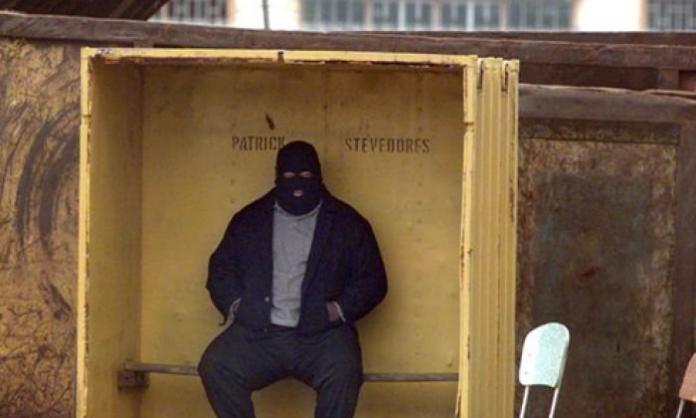Under the cover of darkness, at midnight on 7 April 1998, balaclava-hooded thugs swarmed onto Australian docks, confronting workers with orders to “Get out! You don’t work here any more!”. Shocked Maritime Union of Australia (MUA) members, employees of Patrick Stevedores, were frogmarched off the job and replaced by non-union scabs protected by security guards with dogs and mace.
The Australian Financial Review hailed this “brilliant, ruthless attack”, heralding the arrival of “a new world of industrial relations”, while government MPs were high-fiving and backslapping each other in Parliament House. Then Industrial Relations Minister Peter Reith saw the crushing of the MUA in the 1990s as “correcting the ruling class mistakes of 100 years ago”, when governments had failed to smash organised labour on the wharves in the 1890s.
But by the next morning there were picket lines at Patrick’s waterfront operations around the country, as hundreds of unionists, students and retirees rallied to protest the shock sacking. It was, said one dock worker, “the fight of the whole trade union movement and the whole working class of Australia”. Just one month later, 80,000 workers struck and marched through the streets of Melbourne roaring: “MUA—here to stay!”, and “The workers united will never be defeated!”.
It’s now the 25th anniversary of this full-frontal attack on one of Australia’s most militant unions. The battle between Patrick Stevedores (attack dog of the Howard government) and the MUA appeared “like a flash of lightning across the political landscape”, as socialist writer Tom Bramble put it in an essay on the dispute. Open class warfare was on the front page of the newspapers and headed every evening news.
When the fight was over, Patrick’s boss Chris Corrigan was forced to take the MUA members back, the union stayed on the wharves, and the scabs were sacked. The national and international trade union solidarity demonstrated on the Australian waterfront in 1998 slowed the Howard government’s anti-union offensive, seriously damaged the political career of aspiring party leader Peter Reith and was in part responsible for the government losing fourteen seats at the federal election later that year. But many rank and file militants bitterly concluded in the aftermath that the union had won the battle but lost the war.
During the 1996 election campaign, John Howard had claimed that his vision was for a “relaxed and comfortable” Australia. Within days of taking office, the new Coalition government demonstrated that this was a lie. One of its first acts was to set up task forces to design a new industrial relations regime, alongside so-called waterfront reform laws. A new Workplace Relations Act was enacted in January 1997, providing the laws necessary to hamper unions’ industrial power. The final plans for the waterfront, the “interventionist strategy”, were signed off by the government in July 1997. By 1998, the brutal class nature of John Howard’s Australia was on full display.
From the early planning in 1997 through to the final days in May 1998, the government and Patrick’s Chris Corrigan plotted and schemed, twisting and rewriting the laws in their attempt to smash the Maritime Union of Australia.
There was an economic interest in this attack: to bring down the costs of stevedoring and boost the companies’ profits, and to stop the MUA from threatening bosses’ profits by shutting down the wharves and restricting trade. But there was politics to this as well. The MUA and its predecessors had a history of taking militant action over everything from supporting Indonesian independence, against South African apartheid, fighting for its own members’ wages and conditions, to solidarity actions with other workers. Smashing the militant waterfront union would be a foreboding message to every other union in the country.
Patrick Stevedores repeatedly tried to provoke the MUA into taking strike action, giving the government the trigger to deregister the union. The MUA didn’t bite, part of its questionable strategy of relying more on court action than its members’ industrial strength. Armed with millions of dollars of government funding, Patrick secretly recruited ex-military and police, planning to train them in Dubai to replace the union workforce. The manoeuvre failed spectacularly when the MUA called for international maritime bans. Another attempt to use non-union labour on the Cairns docks similarly fell afoul of international solidarity.
Patrick’s next step was more successful. In January 1998, the company replaced union members with non-union labour at Webb Dock in Melbourne. Patrick succeeded in establishing this beachhead of non-unionism in no small part because the MUA refused to allow picketers to block the scabs, shut down the dock or close the waterfront nationwide by calling out all their members from Patrick and rival stevedore P&O. No wonder the government and Patrick felt they were on the way to victory.
Getting wind of an imminent attack in early April, the MUA again went to court to stop Patrick’s plans to sack its entire workforce. But Patrick had already legally shed its workforce through outsourcing to a labour hire company. All it had to do was notify the firm it would no longer need its labour-hire workers, leaving the wharfies jobless and the stevedore free to hire directly this new, non-union, workforce.
Now, with a trained non-union crew and full government support, Patrick was ready to move. On the night of 7 April, as the goons and dogs raided the docks, 1,700 were sacked. The government crowed that the MUA was off the wharves, soon to be finished for good.
But they had underestimated Australian workers. The response around the country was electric—not just on that first day, but every day until the end. Community assemblies, pickets by another name, were set up at the entrance to every Patrick Stevedores operation in the country. Tens of thousands of workers walked off the job to go to the MUA picket lines, joined by students, community groups and the like, who supplied food, music and solidarity.
During the lockout in Melbourne, warehouse workers from the big supermarket chains, construction workers, truck drivers, manufacturing workers and coal miners all took action in support of the wharfies. Several unions announced they would take illegal action if the MUA called for support. Unionists at Telstra told their officials they were prepared to “go to any extremes” to back the wharfies. The South Australian United Trades and Labour Council promised support for a general strike.
The biggest gathering on the waterfront was a major showdown on 17 April at Melbourne’s East Swanson Dock. Tipped off that the police were going to try to break the picket in the morning, thousands of unionists and supporters poured down to the wharves. Helicopters buzzed overhead, shining their lights down as the police formed into lines. Just as it looked like the cops would charge, several thousand construction workers marched over the hill to come to the aid of the picket. The cops were sandwiched between the construction workers and the picketers and had to beg to be let out!
Not for a long time in Australian society had the question “Which side are you on?” been so clearly posed. People who only a few months before had despaired of workers’ passivity now saw the class’s strength in the mass pickets and walkouts across the nation.
There was so much potential for workers and unions to turn back the tide of union defeats that had blighted the workers’ movement for years. The union movement had the government and employers on the back foot. Laws prohibiting union solidarity action were powerless in the face of the mobilisations in support of the MUA. It was rank and file pressure that pushed the government to the brink, forced Victorian Trades Hall to hold the 80,000-strong rally and strike in May, kept the picket lines strong and built nationwide solidarity.
On 4 May, the High Court confirmed an earlier Federal Court decision to order Patrick to reinstate the sacked workers and to start negotiations over a new industrial agreement. But while wharfies were relieved to get their jobs back, the subsequent agreement was a disaster. It cut hundreds of permanent jobs, imposed significant wage cuts and introduced widespread casualisation. The union also agreed to drop court action against government ministers and the company for what it had argued was a conspiracy to destroy the union. One wharfie slammed the leadership for its “betrayal” over the final settlement, commenting that it “follows a decade-long pattern by union officials of acting as industrial police for the employers”. How did this happen?
At each point, there were decisive weaknesses in the union response. Despite nationwide pledges of solidarity action from many unions—enough to shut industry down—the Australian Council of Trade Unions and MUA leadership refused to call them out. When the Australian Workers’ Union promised a national oil strike if wharfies were sacked, the ACTU talked about raising funds instead. In Queensland, the local Trades and Labour Council leader even reported that he’d been “putting out fires” around the state. The ACTU and MUA leadership’s strategy was to rely on the courts and avoid militancy for fear of jeopardising the ALP’s prospects in the coming election.
It was a leadership strategy of “deflect and defeat” instead of “stand up and smash”.
There’s no doubt that it was the unions’ rank and file who held the line, making sure that the waterfront stayed unionised and that employers had to negotiate rather than dictate.
In the MUA itself, the officials sidelined the members. The union had regular members’ meetings and a generally more democratic and representative structure than others. It took several heated meetings before the officials could force through the final agreement in Melbourne, and Sydney was a “go slow” port for months afterwards. But in the end, the rank and file weren’t able to break through the officials’ hold. The democratic culture of the union had been undermined by MUA leaders who had for years been trading away jobs and conditions.
Despite this, the struggle gave heart to many workers—you could sense the growing self-confidence at the time. But to have won that battle, and to win the battles of today, we need more than rank and file militancy: we need rank and file political leadership to challenge backsliding by the union leaders. We need a broader fight too, and a politics that links every attack on workers and the oppressed to its root cause, capitalism.
No matter how much the union bureaucrats and politicians betray us, they can’t take away the memory of those days of solidarity on the docks. A chorus line from one of the songs written at the time sums it up:
And with these arms our strength combined
And with these arms we turned them back
With these arms—Arms more used to holding babies, arms more used to sorting paper, arms that raise buildings to the sky—We held the line.









